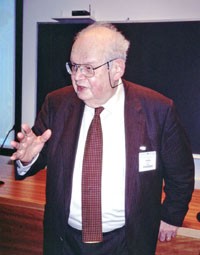Personal tools
News from ICTP 113 - Profile

Benoît Mandelbrot, whose keen intellect has opened our eyes and minds to fractals, visited ICTP last autumn to share his insights into his unique world of shapes and images.
Mr. Fractal

Last November Benoît
Mandelbrot, a maverick scientist and the 'father of fractals,'
celebrated his 80th birthday at ICTP. It was his fifth visit to
the Centre. Participating in the Conference on Practical Applications
of Fractals, he brought with him copies of his latest book, The
(Mis)behavior of Markets (Basic Books, 2004), written with
Richard L. Hudson, former managing editor of the Wall Street
Journal European Edition.
The application of fractal geometry to modern financial theory
is just the latest and perhaps most provocative and controversial
area in which fractals have been used. Indeed it's fair to say
that Mandelbrot has been an intellectual provocateur virtually
his entire life. Born in Poland and educated in France, he derived
a deep interest in numbers, patterns and graphs from his uncle,
a mathematician. Yet he describes his unique abilities as a 'mysterious
gift' that has shaped his thinking since his youth: "I was
19 and when a professor described a mathematical problem, I saw
pictures in my mind, and the pictures instantly suggested the
solution to the problem."
After World War II, professors told him that abstract mathematics
drove scientific understanding and that pictures had nothing to
do with mathematics. "I was publicly insulted by people who
said that what I was doing was an intellectual scandal,"
Mandelbrot now recalls with a sly smile.
The journey from pictures to fractals and from fractals to mathematics
was clearly mapped out in Mandelbrot's mind at an early age. Against
the advice of professors and colleagues, he left École
Normale Supérieure for Polytechnique and soon
began to study the bizarre shapes of nature, whose parts often
mimic the whole. This concept of 'self-similarity' can be applied
to a coastline, a leaf, a cloud. In 1958, Mandelbrot settled in
the United States where he has lived and worked ever since: first
at Caltech in Pasadena, California; then at the Institute for
Advanced Study in Princeton, New Jersey (where he studied with
the renowned mathematician John von Neumann); the Massachusetts
Institute of Technology (MIT); Harvard; and Yale. He eventually
landed a job at IBM's Thomas J. Watson Research Center in Yorktown
Heights, New York.
Mandelbrot coined the word 'fractal' from the Latin word 'fractus'
('broken') to describe his new geometry of nature. In 1975, he
wrote his best-known book, Les objets fractals. The expanded
English version was published in 1982 under the title The Fractal
Geometry of Nature.
In 1987, Mandelbrot was appointed Sterling professor of mathematical
sciences at Yale. By then, fractal geometry was recognised as
a respectable branch of mathematics, explaining the shapes of
the clouds as well as the distribution of galaxies in the universe.
It also received notoriety in circles beyond science---for example,
in computer animation (helping to create alien landscapes in Star
Wars movies) and ultimately as a model of price changes in
financial markets. The public, however, best knows fractals as
a kaleidoscope of images and bright colours that helped define
'pop art' in the 1970s and 1980s---images and bright colours that
are, in essence, pictures of the Mandelbrot set. In 1993, Mandelbrot
was awarded the prestigious Wolf Prize for Physics for "having
changed our view of nature."
Today Mandelbrot lives in the leafy suburb of Scarsdale, just
north of New York City, where he continues to revel in his maverick
ways as the world's 'hippest' mathematician. He remains as dedicated
as ever to writing, speaking and travelling widely to explain
his once iconoclast but now increasingly mainstream concepts.
His friends say he is a living symbol of the richness of complexity
and interdisciplinary thought. His critics assail the supreme
confidence that lies behind his staunch defence of his work.
"I have been a lone rider so often and for so long that I'm
not even bothered by it anymore," he says in the opening
pages of his latest book. Adds his co-author Richard Hudson: "As
a mathematically minded friend put it, he moves 'orthogonally'
to every fashion."